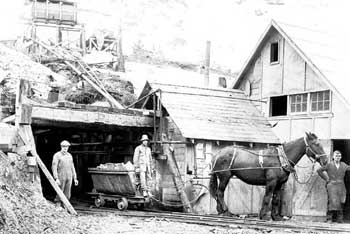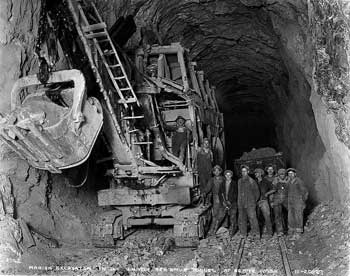Lee Pickett Photographs of Washington State, 1909-1936
The Lee Pickett collection of over 900 photographs documents scenes from Snohomish, King and Chelan Counties in Washington State from the early 1900s to the 1940s. Based in Index, in the heart of the Cascade Mountains, he took thousands of photographs of that region. This includes the towns and people of Index, Gold Bar, Scenic, and Sultan. Local industries, such as the Heybrook Lumber Co. and Index Granite Works, are also depicted. Pickett was perhaps best known for his job as official photographer for the Great Northern Railway Company. A large number of his photographs reflect the program undertaken by the company in the 1920s to improve the line over the Cascade Mountains.
Lee Pickett was born in Big Rapids, Michigan where he attended public school and was employed as a bookkeeper. In 1898, he came to Washington with his grandfather, stopped briefly in Snohomish Co. and proceeded to Nome, Alaska, where they spent one season. After returning to Michigan to complete his education and learn photography, he moved back to Washington State and opened a photography studio in Seattle. He was in business for three years before he embarked on a tour down the West Coast to California, New Mexico and then eastward visiting Chicago, Montreal and Nova Scotia. Apparently he did a fair amount of scenic photography for the Grand Trunk and Canadian Pacific Railroad Companies during this time.
Returning once again to Seattle in 1909, he relocated to Index the following year. Continuing his photographic career, he photographed, among other things, the construction of some of the first passable roads in Snohomish County. The first road from Index to Galena was built in 1912 and his photographs record the first automobile, a Flanders 20, to navigate the still often muddy roadway.
Pickett became the exclusive photographer for the Great Northern Railway Company during the 1920s. According to Dorothy Pickett, his third wife, he was the only person besides the president of the railway to be able to order a train stopped anywhere along the line so he could take a picture. Many of his photographs document improvements made in the Great Northern line over the Cascade Mountains in this period. At that time, the company sought to undertake a program of electrification, grade reduction, and the elimination of snowsheds between Wenatchee, on the east slope of the Cascades, to Gold Bar, on the west slope. The most important part of this improvement was the construction of the 8 mile Cascade Tunnel from Berne to Scenic as protection against avalanches and adverse weather conditions. This work was accomplished in a record breaking three years, a major engineering feat at the time.
Soon after the tunnel project was finished, Pickett returned to being a freelancer, often taking photographs for insurance purposes. Much of his logging and mining camp work reflect this activity. Pickett was not only a photographer, but an avid mountain climber, an insurance salesman, and an odd-jobs man. He worked at the shipyards in Anacortes during the first and second World Wars. He also served on the Index City Council. Pickett quit the photography business in the late 1940s, claiming that the processing chemicals were making him ill. Lee Pickett died in 1959.
Quick Facts about the Tunnel
Railroad magnate James Jerome Hill, popularly known as the 'Empire Builder' founded the Great Northern Railway in Minneapolis in 1889. As part of his empire-building efforts, in 1896 Hill negotiated a transportation arrangement with Nippon Yusen Kaisha, the largest steamship line in the Pacific, which connected Seattle to the Orient. With this arrangement, Hill decided he wanted a faster route to Seattle from the Midwest, and thus the idea of the Cascade Tunnel-a tunnel through the Cascade Mountains, rather than around them-was born.
Time to build: Four years. It was begun in 1925 and completed in 1929. A separate ventilation project was completed in 1956, which allowed diesel engines in the tunnel, and marked the end of electric train operations.
Length: 41,183 feet, or 7.8 miles, which at the time of completion was the longest railroad tunnel in the western hemisphere.
Elevation: 2,881 feet above sea level.
Useful Links
www.gngoat.org -- An interesting site maintained by a Great Northern Railroad enthusiast.
www.gnrhs.org -- Official site of the Great Northern Railroad Historical Society.
www.bnsf.com/about_bnsf/html/history.html -- History page on the Burlington Northern Santa Fe Railroad website, describing the history of all the railroads that merged (including the Great Northern Railway) to create the Burlington Northern Santa Fe Railroad.
About the Database
The information about the Lee Pickett Collection was researched and prepared by the UW Libraries Special Collections Division and Cataloging staff in 2001. Not all the photographs from the collection were included in this database: the database consists of over 500 digital images chosen from a larger group of photographic prints. The images were scanned from glass plate negatives or original photographic prints in grayscale using a Microtek Scanmaker 9600L and saved in .jpg format. Some manipulation of the images was done to present the clearest possible digital image. The scanned images were then linked with descriptive data using the CONTENT software suite. The original collection resides in the UW Libraries Special Collections Division as the Lee Pickett Collection no. 580.


